跨文化交际-黑龙江大学-崔常亮老师-chapter 2 Communication and International Communication
- 格式:ppt
- 大小:3.33 MB
- 文档页数:46
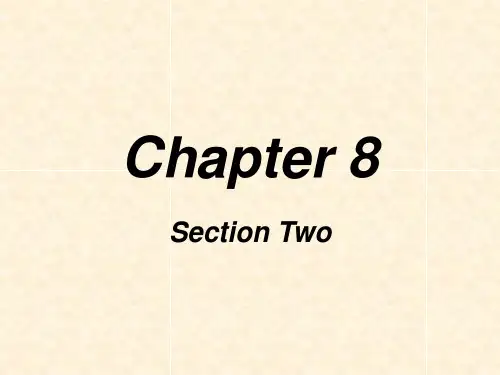

黑龙江大学外语部第一教学中心跨文化交际教研室集体备课记录_2006-2007_学年__秋季__学期日期: 2006年 8 月 30 日时间:_13:30_至14:30___ 主讲教师: _艾军________________ 记录教师: _刘晓丹__________________ 参加教师:____跨文化交际教研室全体教师黑龙江大学外语部第一教学中心跨文化交际教研室集体备课记录_2006-2007学年__秋季__学期日期:2006年 8 月 30 日时间:_13:30_至14:30__主讲教师: _常开媛__________ 记录教师: ___张知博________________参加教师:____跨文化交际教研室全体教师黑龙江大学外语部第一教学中心跨文化交际教研室集体备课记录_2006-2007_学年__秋季__学期日期: 2006年 9 月 6 日时间:_13:30_至14:30___ 主讲教师: _艾军________________ 记录教师: _董璇 __________________ 参加教师:____跨文化交际教研室全体教师黑龙江大学外语部第一教学中心跨文化交际教研室集体备课记录_2006-2007_学年__秋季__学期日期: 2006年月日时间:_13:30_至14:30___ 主讲教师: _______金梅_______ 记录教师: __________________参加教师:____跨文化交际教研室全体教师黑龙江大学外语部第一教学中心跨文化交际教研室集体备课记录2006-2007学年秋季学期日期:2006年9 月 25日时间:14:00至15:00 主讲教师: 李晓光记录教师:参加教师:跨文化教研室全体教师黑龙江大学外语部第一教学中心跨文化交际教研室集体备课记录_2006-2007_学年__秋季__学期日期: 2006年 9 月 27 日时间:_13:30_至14:30___ 主讲教师: _宋冰________________ 记录教师: _刘晓丹__________________ 参加教师:____跨文化交际教研室全体教师黑龙江大学外语部第一教学中心跨文化交际教研室集体备课记录_2006-2007_学年__秋季__学期日期: 2006年 10月 18日时间:_13:30_至14:30___ 主讲教师: 国玮秋________________ 记录教师:刘洋参加教师:____跨文化交际教研室全体教师黑龙江大学外语部第一教学中心跨文化交际教研室集体备课记录__2006-2007____学年___秋学期日期:年月日时间:______至_______ 主讲教师: ___王凤____ 记录教师: ___王玉双________________参加教师:______跨文化交际教研室全体教师黑龙江大学外语部第一教学中心跨文化交际教研室集体备课记录_2006-2007_学年__秋季__学期日期: 2006年 10 月 25 日时间:_13:30_至14:00___ 主讲教师: _杨白________________ 记录教师: _杨白__________________参加教师:____跨文化交际教研室全体教师黑龙江大学外语部第一教学中心跨文化交际教研室集体备课记录_2006-2007_学年__秋季__学期日期: 2006年 10 月 25 日时间:_13:30_至14:00___ 主讲教师: _杨白________________ 记录教师: _杨白__________________参加教师:____跨文化交际教研室全体教师黑龙江大学外语部第一教学中心跨文化交际教研室集体备课记录_2006-2007_学年__秋季__学期日期: 2006年 11 月 29 日时间:_13:30_至14:30___主讲教师: _张丽娇________________ 记录教师: _艾军__________________参加教师:跨文化交际教研室全体教师黑龙江大学外语部第一教学中心跨文化交际教研室集体备课记录_2006-2007_学年__秋季__学期日期: 2006年 12 月 6 日时间:_13:30_至14:30___ 主讲教师: _郑春梅________________ 记录教师: ____________参加教师:____跨文化交际教研室全体教师黑龙江大学外语部第一教学中心跨文化交际教研室集体备课记录_2006-2007_学年__秋季__学期日期: 2006年 12 月 7 日时间:_13:30_至14:30___ 主讲教师: _严明______________ 记录教师: _艾军__________参加教师:____跨文化交际教研室全体教师亲贤臣,远小人,此先汉所以兴隆也;亲小人,远贤臣,此后汉所以倾颓也。
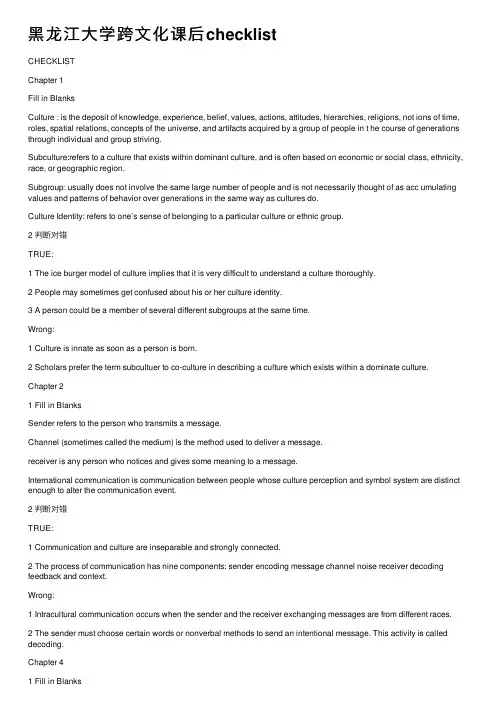
⿊龙江⼤学跨⽂化课后checklistCHECKLISTChapter 1Fill in BlanksCulture : is the deposit of knowledge, experience, belief, values, actions, attitudes, hierarchies, religions, not ions of time, roles, spatial relations, concepts of the universe, and artifacts acquired by a group of people in t he course of generations through individual and group striving.Subculture:refers to a culture that exists within dominant culture, and is often based on economic or social class, ethnicity, race, or geographic region.Subgroup: usually does not involve the same large number of people and is not necessarily thought of as acc umulating values and patterns of behavior over generations in the same way as cultures do.Culture Identity: refers to one’s sense of belonging to a particular culture or ethnic group.2 判断对错TRUE:1 The ice burger model of culture implies that it is very difficult to understand a culture thoroughly.2 People may sometimes get confused about his or her culture identity.3 A person could be a member of several different subgroups at the same time.Wrong:1 Culture is innate as soon as a person is born.2 Scholars prefer the term subcultuer to co-culture in describing a culture which exists within a dominate culture. Chapter 21 Fill in BlanksSender refers to the person who transmits a message.Channel (sometimes called the medium) is the method used to deliver a message.receiver is any person who notices and gives some meaning to a message.International communication is communication between people whose culture perception and symbol system are distinct enough to alter the communication event.2 判断对错TRUE:1 Communication and culture are inseparable and strongly connected.2 The process of communication has nine components: sender encoding message channel noise receiver decoding feedback and context.Wrong:1 Intracultural communication occurs when the sender and the receiver exchanging messages are from different races.2 The sender must choose certain words or nonverbal methods to send an intentional message. This activity is called decoding.Chapter 41 Fill in BlanksEthnocentrism:refers to negatively judging aspects of another culture by the standards of one’s own culture Prejudice: It refers to the irrational dislike, suspicion, or hatred of a particular group, race, religion, or sexual orientationRacism: It refers to any policy, practice, belief, or attitude that attributes characteristics or status to individua ls based on their raceStereotypes: They refer to negative or positive judgments made about individuals based on any observable or believed group membership2 判断对错TRUE:1 Ethnocentrism stereotypes prejudice and racism are learned.2 Although stereotypes are considered as being negative judgments,they can also be positive.3 When communicating with people other cultures,an individual sometimes is likely to treat them as“his people”and to assume there is only one way of doing things: that is “his way”Wrong:1 Assumption of superiority may lead to assuming similarity instead of difference.2 Economy is not the reason for the persistence of ethnocentrism, stereotyping, prejudice and racism.Chapter 51 Fill in BlanksVerbal intercultural communication happens when people from different cultural backgrounds communica te with each other by using language.Pidgin is a special language variety that mixes or lends languages for restricted purposes such as trading Dialect is a form of language peculiar to a group of people, as distinguished from the literary language of the whole people.Taboo refers to prohibition of a set of behaviors that should be avoided because they are offensive and impol ite2 判断对错TRUE:1 The elaborate,exacting,or succinct communication style deals with the quantity and/or volume of talk that is preferred across cultural groups.2 Dialect refers to geographic variation, while sociolect refers to variation in terms of social group.3 An elaborate style of communication can be seen in Arab cultures.Wrong:1 The exacting style of communication can be found in Japan,China,and some Native American cultures2 The self-effacement verbal styles emphasizes the importance of boasting about one’s accomplishments and abilities. Chapter 61 Fill in Blanksnonverbal communication: It refers to the messages sent without using words.Oculesics: It is the study of communications sent by the eyes.Proxemics: is the way we use fixed space and personal space.Kinesics includes gestures, body movement and facial expressionsChronemics: It is the study of how people perceive and use time.2 判断对错TRUE:1 Saudi Arabs belong to touch cultures.2 The appropriateness of eye contact varies with different cultures.Wrong:1 Speaking is the only mode of effective communication.2 The Thais like to touch babies or small children,especially they like others to pat their children’s head.3 Paralanguage may imply the connotation of the actual words.Chapter 71 Fill in Blanks1 Members in the culture of high Uncertainty avoidance have a lower tolerance for uncertain and ambiguity.2 Individuals from high power distance accept power as part of society.As a result,superiors consider their subordinates to be different from themselves and vice versa.3 People from high masculine cultures tend to see same-sex relationships as more intimate than opposite-sex relationships.4 In collective societies such as those in Pakistan,Colombia,Venezuela,China and Peru people are born into extended families that support and protect them in exchange for their loyalty.2 判断对错TRUE:1 In industrialized societies like the United States,the mastery-over-nature view tends to predominate.2 A doing orientation involved in focus on those types of activities which have outcomes that can be measured by someone else.3 In Beijing cultures,social status and position are more important than what a person does.Wrong:1 The harmony-with-nature orientation draws clear distinctions among human life,nature,and the supernature2 Both Americans and British shoe respect for tradition.Chapter 81 Fill in Blanks1 In Japan ,business is not conducted in obon (in mid-August),because many people travel to the graves of their ancestors.2 In India ,“the traditional greeting is the namaste formed by pressing the palms together,fingers up,below the chin.A slight bow may be added to show respect.”3 In Israel,the Jewish holy night, the sabbath begins at sunset on Friday and ends at sunset onSaturday.Therefore, the business week runs from Saturday through Thursday.Conducting business on the holy day would be highly inappropriate.4 In Saudi Arabia. No business is conduced during the three-day festival of breaking fast at the end of the month of Ramadan.2 判断对错TRUE:1 In Finland, firm handshakes are the normal greeting for men and women.2 Americans might regard gift giving as a form of bribery.3 Mexican negotiators emphasize relational concerns prior to the real negotiation.Wrong:1 In Saudi Arabia,the greeting tend to be informal.Both men and women shake hands on meeting and leaving.2 In Japan,one should open the gift in front of the giver.Chapter 91 Fill in BlanksHoneymoon is the first stage of the interculture adaptation when everything is new and exciting. Segregation occurs because the more politically and economically powerful culture does not want the interc ultural contact with the immigrants Integration: is desire a high level of interaction with the host culture while maintaining identity wit h their native culture Assimilation is a process in which members of an ethnic group are absorbed into the dominant culture, losin g their culture in the process.Marginalization occurs when the individual chooses not to identify with his or her native culture or with the host culture.2 判断对错TRUE:1 Successful management of culture shock depends on an awareness of its symptoms and the degree of its severity.2 Financial matters can results in culture shock.Wrong:1 Similarity of culture does not affect acculturation.2 The second stage of interculture adaptation is called honeymoon stage or initial euphoria stage.3 All the activities of learning one’s culture are called acculturation.4 Insomnia can be one example of the physical symptoms of culture shock,。

Test Pa pe rⅠ. Filling the bla nks:1.Generally speak in g, in terms o f co ntextuality, theco mmun icatio n in the West is low-contextual while that in the East is high-contextual2.Generally sp eak ing,in terms o f wo rld views,the West ad op ts Dualistic view, whilethe East ado pt s holistic view3.Generally sp eak ing, in terms o f tho ught p atterns, the West fo llo ws Analytic andabstract thinking, wh ile the East fo llo ws synthetic and concrete thinking4.Generally speak in g, in terms o f d isco urse patterns, the West uses Deductive pattern,while the East uses inductive pattern5In the Axial Age,the great think ers in C hina are Confucius, Lao Tze, Mo Tze, and the great think er in Ind ia is Siddhartha Gautama,the great figure in P alestine are Hebrew prophets, and the great think ers in the West are Pla to, Ho me r and ArchimedesⅡ. Choose the best a ns we r:1.No n-verbal messages are classified into two co mp rehensive categories: tho se thatare p rimarily prod uced b y the bo d y, such as_________,________,_______; and tho se tha t the ind ivid ual co mb ines with the settin g, such as _______, _______, _______.DA.p hysical co ntact, eye co ntact, paralanguage; space, time, manB.facial exp ressio n, to uch, taste; sp ace, time, silenceC.app earance, mo vement, gesture; surro und in g, occasio n,manD.mo vement, smell, p aralanguage; sp ace, time, silence2.In C hinese writing,there are usually mo re ad jectives,p ro verbs and allus io ns thanin Eng lish writing.S o me Western scho lars name th is style “flo wery”,stating that its aim is to give a mo re fancifu l imp ressio n than in fo rmatio n, and the in fo rmatio n is usually o f beauty, fragrance, hap p iness, and any other “go od ness”aspects so as to attract p eop le. We may term this style as_______-o riented. Western writin g is mo re d irect with ob jective in fo rmatio n.To them, much-rep eated words may mean less after a while. We may term the Western writing as ________-oriented.CA. ad jective, o bjectiveB. C hinese, WesternC. imp ressio n, in fo rmatio n C. ind irect, d irect3. As to the hu man nature o rientat io n,the trad itio nal Western belief ho lds that_______, while the Asian p eop le b elieve that_______.BA. b asically goo d; basically b adB. ev il b ut perfectib le, basically go odC. the mixture o f go od and evil; the mixture o f good and evil;D. unk no wn4. As to the Man-N ature o rientatio n, the trad it io nal Western b elief ho ld s that _______,while the Asian p eop le b elieve that_______.DA. sub jugatio n to nature; harmo ny with natureB. harmo ny with nature; mastery o ver natureC. harmo ny with nature; sub jugatio n to natureD. mastery o ver nature; harmo ny with nature5. As to time o rientatio n, generally speak in g, the US A is______, the P hilip p in es,Mexico, and Latin America are _____, and Asia,Britain,Greece, F rance are______.CA. o n-time oriented; in-time o riented; late-time o rientedB. yo uth-o riented; ad ult-oriented; eld erly-o rientedC. future-o riented; present-oriented; past-orientedD. p resent-o riented; fut ure-oriented; past-oriented6. In terms o f activ ity or ientatio n, the US A is______, the P hilip p ines, Mexico,andLatin A merica are _____, and Asia is ______.DA. d o ing-o riented; p lay ing-o riented, b eing-o rientedB. p lay ing-o riented; bein g-oriented; do in g-orientedC. b eing-o riented; do ing-o riented; being-in-b eco min g o rientedD. d o ing-o riented; b eing-o riented; b eing-in-b eco min g o riented7. The d iv id ing world v iew is also referred to as mechanist ic view. It goes b y thefo llo wing d ifferent names: DA. reaso n versus result; religio n versus ar t; ob jectiv ity versus imaginatio nB.instinct versus intuit io n; science versus techno lo gy; imaginatio n versussub jectiv ityC. tuit io n versus intu itio n; regio n versus religio n; sub jugatio n versus sub jectiv it yD. reaso n versus int uit io n; science ve rsus religio n; ob jectiv ity versus sub jectiv ity8. The Greek think s in o rder to _______.It is speculatio n. The Hind u think s in o rd er to_______. It is med itatio n.The C hinese think s in o rd er to_______.It is co ntemp latio n.CA. d o; d ie; liveB. spectacle; medd le; co ntemp tC. understand; think; self-cult ivateD. think; self-cult ivate; understand9. “Yo ur bod y d oesn’t k no w how to lie”ind icates_____BA. so methin g is wro ng with yo ur bo d y and yo u can o nly stand.B. b od y language is impo rtant.C. b od y co ntact is dangero us.D. we can’t separate mind fro m b od y.10.Generally speak ing,in the US,p eo p le mak e friend s b y sharing ______,while inChina, peop le mak e friend s b y sharin g _______.BA. p erso na l relatio nship; activit iesB. activ ities; perso nal relatio nshipC. lo ve; b lo odD. b lo od; lo ve11.In terms o f p hysical co ntact, the high co ntact co untries are__________________________________, while the lo w co ntact co untries are ________________________________.CA. the US, Britain,most Northern Europ ean co untries; Arab world, Med iterraneanco untries, Indo nesiaB. the US,Britain, Japan; East Europ ean co untries, Russia, Mid d le EastC. Arab wo rld, Med iterranean co untries,Ind o nesia; the US, Britain,mo st No rthernEuro pean co untriesD. Arab wo rld, Med iterranean co untries, C hina; the US, Britain, mo st N orthernEuro pean co untries12.Generally sp eak in g,in terms o f co ntextualit y o f co mmu n icatio n,thehig h-co ntextual pe op le are __________________________________, wh ile the lo w-co ntextual co untries are ________________________________AA. Latin A mericans, C hinese, Japanese; the Americans, German, SwissB. the Americans, German, Swiss; Latin Americans, C h inese, J ap aneseC. Native Americans, C hinese, Ko reans; the Americans, Japanese,Brit ishD. the Americans, Jap anese, British; N ative Americans, C hinese, Ko reans13.Each perso n has a “b ub b le”o f sp ace (territo ry).S tud ies sho w that peo p le fro m________, ________,________have a smaller p erso nal territory than d o p eop le fro m ________, ________,_________.AA. So uth America,Arab co untries, and many Asian co untries; North America,Britain, GermanyB. No rth America,Britain, Germany; So uth America, Arab co untries,and manyAsian co untriesC. S o uth America,Britain, Germany; No rth America, Arab co untries,and manyAsian co untries.D. N orth America, Arab co untries, and many Asian co untries; So uth America,Britain, Germany14.In ___________cu lture,the nuclear family is much mo re imp o rtant to theind ivid ual than the extended family,while in ____________, ________, _______, ________ cu lture, the extended family is very impo rtant. CA. Hispanic; American, Asia n, Arab ian, AfricanB. Arab ian; American, Asian, African, Hisp anicC. American; Asian, African, Arab ian, Hisp anicD. African; American, Asian, Arab ian, Hispan ic15. In nuclear-family culture, p eo p le rely main ly o n ______, ______, ________for help,while in extended-family culture, peop le rely mainly o n ________for help.CA. families,friend s, pro fessio nals; familiesB. families, friend s, pro fessio nals; inst itutio nsC. friend s, pro fessio nals, institut io ns; familiesD. friend s, famil ies, inst itutio ns; p ro fessio nals16. In nuclear-family culture, ______ usually co mes first, while in extended-familyculture, _______ usually co mes first. BA. family; ind iv id ualB. ind ivid ual; familyC. husband; wifeD. wife; husb and17.W hen it c o mes to friend ship, an American friend wo uld feel that they had _______if the friend gave up a real need to stud y to go sho pp ing.O ne’s d uties and ob ligatio ns to ward friend s,even b est friend s are understo od to ______; o ne does not exp ect friend s to assume b urdenso me, ______ resp o nsib ilit ies toward o neself.A close friend in the US is a p erso n that o ne feels free to ask fo r help, reco gn izin g, ho wever, that the friend may _____, if they give yo u a reaso n. This is mayb e that in the West,p eop le p refer to be ______,so they do no t feel co mfo rtab le in a relatio nship in which o ne p erso n is ______ mo re and the o ther is dependent o n what is being given.Fo r Westerners friendship is mostly a matter o f p ro vid ing ______sup po rt and ______. BA. d ep end ed too much; limitless; small; say “OK”; dep endent; receiv ing; material;get sep arateB. imp osed too much; have limits; lo ng-term; say “No”; ind ep end ent; giv ing;emotio nal; spend time to gether.C. imp osed too little; have limits; sho rt-term; say “Yes”; free; earning; financial; getinvo lvedD. depended a little; limitless; b ig; say “S orry”; independent; giv ing; sp iritua l; getto gether.18. In C hina, the d uties and o b ligatio ns o f friend ship s seem v irtually ________for allpractical p urpo ses.C hinese friend s give each other much ________ ________help and assistance than Western fr iends do. F or examp le, they give each o ther _______ and might help each o ther _______fo r a _______period o f time. A friend in C hina is so meo ne who,sensing that yo u are in need in so me way,o ffers to assist yo u _________.CA. imp o ssib le; mo re sp irit ual; things; p ractically; short; when being askedB. eno rmo us; less sp iritual; mo ney; financia lly; lo ng; unwilling lyC. unlimited; more co ncrete; mo ney; financially; lo ng; witho ut wait in g to be askedD. limited; mo re co ncrete; things; materially; certain; if req uired19. In times o f tro ub le, bo th American and C h inese fr iends g ive each other emo tio nalsup po rt, b ut they do it d ifferently. A C hinese friend is mo re lik ely to be ________ to give _______ ad vice to a friend, while an American fr iend will be ________ to give ________ad vice,instead she may raise q uestio ns to enco urage her friend to co nsider carefu lly what may hap pen if she does o ne th ing instead o f ano ther. CA. cautio us; d etailed; read y; specificB. read y; amb iguo us; cautio us; guid elineC. read y; sp ecific; cautio us; d irectD. unwilling; d irect; read y; sp ecific20.When it co mes to the relatio nsh ip b etween parents and married so ns, in C hina, aman’s relatio nship with h is p a rents is _______ than that with h is wife. Thus in the event o f any q uarrel b etween his wife and his mo ther, a man sho uld ____________.At mo st he might hop e to__________, and this was regard ed as ________.In America, a man’s relatio nsh ip with his parents is _______ than that with his wife.He wo uld be expected to______________. He might even b e co unseled to _______________ the vic in ity o f his parents’ho me to ease the co nflict. DA.more imp o rtant; sid e with h is mo ther; sid e with h is father; ho norab l e; mo reimpo rtant; side with no o ne; mo ve intoB. less imp ortant; sid e with no o ne; say so mething; ho no rab le; less imp o rtant; sidewith his father; get away fro mC. less imp o rtant; sid e with h is wife; remain silent; d isho no rab le; mo re imp o rtant;side with h is wife; mo ve intoD. mo re imp o rtant; sid e with h is mo ther; remain neutral; d isho norab le; less imp o rtant;side with h is wife; mo ve awayⅢ. True o r fa lse:1.Generally sp eak ing, C hina is an eq ual so ciety, America is a hierarchy society. ( F )2.Generally speak in g, in C hinese so ciety, the po wer d istance is small, while inAmerica, the p o wer d istance is large. ( F )3.Bo th the Asian and Western co untries have the co ncep t o f “face”, and“face” has thesame so cial sig n ificance fo r these co untries in that o ne’s face is also the face o f o ne’s gro up.( F )4.The d ivid ing world v iew relies stro ngly o n “facts” as opp osed to“op in io ns”. ( T )5. A very ro ugh generalizatio n is that think in g for the Greek is to loo k up ward, fo r theHind u is to lo ok inward, fo r the C o nfucians is to loo k o utward. (F )6.Values are exp lic itly sto red in o ur mind. We are always aware o f them, and we makejud g ments accord ing to them. (F)7.Values are sep arate fro m each o ther. Each o ne work alo ne. ( F )8.Values can be co mp ared o n a co ntinu um rather than o ne o f o nly two p ossib lecho ices. Peop le everywhere p ossess the same values to d ifferent d egrees, and the impo rtance o f that co mmo n value, how it gets acted o ut, is a matter o f d egree.( T)9.“Lo ver”and“爱人”have the same meaning.( F)10.I n bo th C hina and We stern co untries,it is very co mmo n and usual fo r ad ults tofo nd le other peo p le’s b ab ies and very small child ren to sho w their affectio n and friend liness. ( F )Ⅳ.Tra nslatio n:1.Tra nslate the follo wing Englis h into Chinese:1)Nature and Man are b lend ed into o ne harmo nio us identity. 天人合一2)Nature affects hu man affairs and hu man behavio r find s resp o nse in Nature.天人感应3)Nature accords with hu man wishes. 天从人愿4)Yo ur character will b e tinted“red”(go od) if yo u are in the co mpany o f “red ness”,b ut “b lack”(bad) if yo u are in close co ntact with ink. 近朱者赤,近墨者黑5)Go d helps tho se who help themselves. 天助自助者6)Lo ok befo re yo u leap. 三思而后行7) A sing le arro w is easily b rok en, b ut no t a b unch.轻霜冻死单根草,狂风难毁万木林He who stirs ano ther’s p orrid ge o ften b urns his o wn. 狗拿耗子,多管闲事8)2.Tra nslate the follo wing Chinese into Eng lish:1)容忍tolerance of others2)中庸之道moderation, following the middle way3)修养self-cultivation4)不重竞争non-competitiveness5)信用trust-worthiness6)贞节chastity in women7)寡欲having few desires8)服从、孝敬、尊崇、赡养父母filial piety。
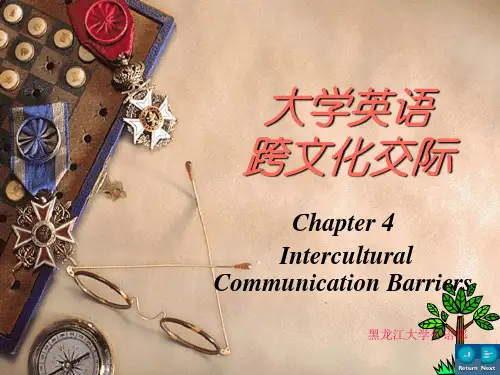
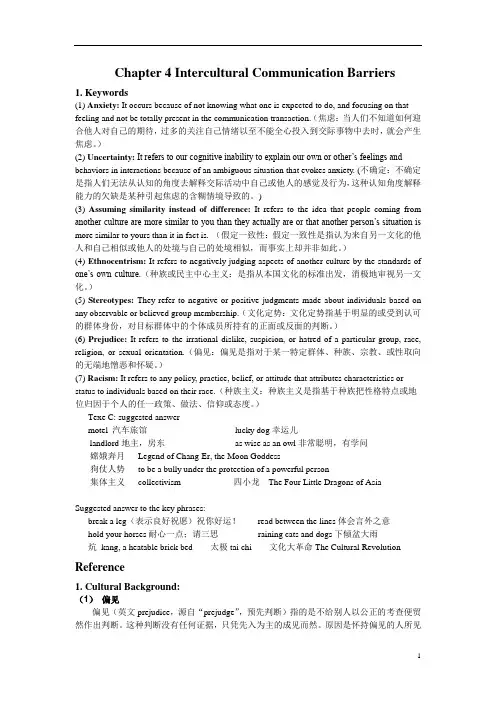
Chapter 4 Intercultural Communication Barriers1. Keywords(1) Anxiety: It occurs because of not knowing what one is expected to do, and focusing on that feeling and not be totally present in the communication transaction.(焦虑:当人们不知道如何迎合他人对自己的期待,过多的关注自己情绪以至不能全心投入到交际事物中去时,就会产生焦虑。
)(2) Uncertainty:It refers to our cognitive inability to explain our own or other’s feelings and behaviors in interactions because of an ambiguous situation that evokes anxiety. (不确定:不确定是指人们无法从认知的角度去解释交际活动中自己或他人的感觉及行为,这种认知角度解释能力的欠缺是某种引起焦虑的含糊情境导致的。
)(3) Assuming similarity instead of difference: It refers to the idea that people coming from another culture are more similar to you than they actually are or that another person’s situation is more similar to yours than it in fact is. (假定一致性:假定一致性是指认为来自另一文化的他人和自己相似或他人的处境与自己的处境相似,而事实上却并非如此。
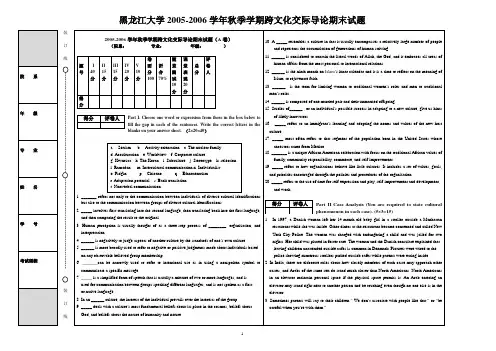
![跨文化交际课123[1]](https://uimg.taocdn.com/0e506a1c59eef8c75fbfb331.webp)

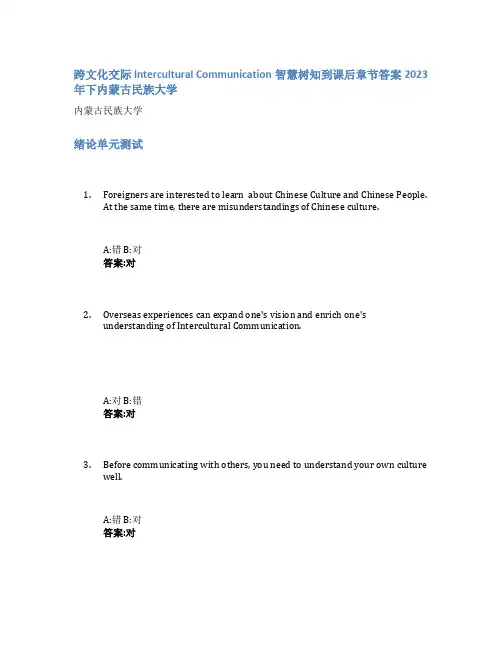
跨文化交际 Intercultural Communication智慧树知到课后章节答案2023年下内蒙古民族大学内蒙古民族大学绪论单元测试1.Foreigners are interested to learn about Chinese Culture and Chinese People.At the same time, there are misunderstandings of Chinese culture.A:错 B:对答案:对2.Overseas experiences can expand one's vision and enrich one'sunderstanding of Intercultural Communication.A:对 B:错答案:对3.Before communicating with others, you need to understand your own culturewell.A:错 B:对答案:对4.Culture learning is not so important as language learning.A:错 B:对答案:错5.Knowing all the words and having perfect grammar of a language is enoughto deal with Intercultural Communication.A:错 B:对答案:错6.Everything abroad is the same as “at home”.A:错 B:对答案:错7.In this course, we are going to learn aboutA:Intercultural communication barriers B:Verbal and non-verbalcommunication C:Thearatical foundations of Intercultural Communication D:Acquring Intercultural Communication Competence答案:Intercultural communication barriers;Verbal and non-verbalcommunication;Thearatical foundations of InterculturalCommunication;Acquring Intercultural Communication Competence8.In the study of intercultural communication, we are going to achieve thegoals ofA:understanding the basic termsB:developing communicative competence C:fostering critical thinking ofdifferent cultures D:avoiding potential problems in interculturalcommunication答案:understanding the basic terms;developing communicative competence;fostering critical thinking ofdifferent cultures;avoiding potential problems in interculturalcommunication9.The course you are taking isA:Phycology B:Communication C:Intercultural Communication D:EnglishLiterature答案:Intercultural Communication10.When being asked by other people about your culture, you will be moreaware of your identity.A:对 B:错答案:对第一章测试1.The dialogues at the United Nations, for example, would be termed _________.A:international communication B:interpersonal communication C:interracial communication D:interethnic communication答案:international communication2.In China, if a Tibetan communicates with a Han, it is _____.A:interracial communication B:international communication C:interethnic communication D:interpersonal communication答案:interethnic communication3._____ is the socialization process you go through to adapt to your society.A:Enculturation B:Deculturation C:Acculturation D:Assimilation答案:Enculturation4.Many of the same proverbs appear throughout the world, because all people,regardless of their culture, share common____.A:experiences B:stories C:languages D:arts答案:experiences5.In the popular cultural iceberg metaphor, you can only see about 10-15%above the surface, most part of the iceberg is under the water, which is a bit of a mystery. Which of the following do you think are above the water?A:clothing B:food C:architecture D:music答案:clothing;food;architecture ;music6.Six reasons of why study intercultural communication were mentioned,please try pick the ones mentioned in the following.A:technology B:imperative C:self-awarenessD:demographic changes答案:technology;imperative;self-awareness;demographic changes7.Culture can be categorized as either material or nonmaterial culture.A:对 B:错答案:对8.Culture is that complex whole whichincludes knowledge,belief,arts,morals,law,custom and any other capabilities and habits acquired by man as a member of society.A:对 B:错答案:对9.It is reasonable that we use what's below our surface to try to understandwhat's above somebody else’s.A:错 B:对答案:错10."Dig the well before you are thirsty" is a Chinese proverb meaning "吃水不忘挖井人”。

本人总结的2011黑大跨文化考试考点,辛苦啊啊~欢迎分享。
所有的概念关键词+所有考试让看的CASE理解。
来源:刘洋 Alina的日志跨文化考试总结(大家考试加油哈!)考试构成:一、单选 1*10=10分。
(Choose the one that)其中有一部分是书中的概念。
二、判断1*10=10分。
(A—>true。
B—>false) 课后习题第二大题,其中某些题是变动的。
要注重理解。
三、搭配1*20=20分。
matching 四组搭配,概念的对应,每一章课后的summary中的黑体字。
四、阅读理解1*20=20分。
四篇。
与课文中的专有词有关。
五、完型填空1*10=10分。
六、案例分析3*5=15分。
五个案例。
书中案例有四个,课外一个。
七、写作15分。
150+words。
可以准备一些跨文化、交际的文章。
四十分钟的写作时间。
8: 00——8:40.作文提前收!注:前六大题是客观题即选择,只有写作是主观题。
课后题:(课后题第一第二大题老师也让多多关注,我这里就不多写啦,除了课后第一第二大题,我这里都全啦)1、P28——P302、P58——P613、P95——P974、P124——P1265、P159——P1626、P194——P1977、P237——P2408、P270——P2729、P304——P306所有概念关键词+考试范围内的CASE:Chapter 1 Culture Keywords “the arts and other manifestations o (1) Culture (from intellectual perspective): Culture is f human intellectual achievement regarded collectively”(从知性角度定义文化:作为整体的人类智力成就的艺术和其他表现。
)(2) Culture (from anthropologic perspective): Culture consists of patterns, explicit and im plicit, of and for behavior acquired and transmitted by symbols, constituting the distinctiv e achievement of human groups, including their embodiments in artifacts; the essential c”.(从人类学ore of culture consists of traditional ideas and especially their attached values角度定义文化:文化由清晰和模糊的行为模式构成,这些模式通过符号获得并传播,这些符号由人类群体的特别成就构成,包括具体的人工制品。
跨文化判断对错〔checklist第二题〕1.T The iceberg model of culture implies that it is very difficult to understand a culture thoroughly.2.F Culture is innate as soon as a person is born.3.T People may sometimes get confused about his or her cultural identity.4.F Scholars prefer the term subculture to co-culture in describing a culture which exists within a dominant culture.5.T A person could be a member of several different subgroups at the same time.6.F Intercultural communication occurs when the sender and the receiver exchanging messages are from different races.7.T Communication and culture are inseparable and strongly connected.8.F The sender must choose certain words or nonverbal methods to send an intentional message. This activity is called decoding.9.T The process of communication has nine components:sender,encoding,message, channel, noise, receiver, decoding, feedback, and context.10.T No two of us can assume that our sensations are the same.Different stimuli can produce the same sensations.11.T The same stimuli can produce very different sensations.12.T Our perception are influenced by who we are, including the accumulation of our experience.13.F We give meaning to or “decode〞the information that we have selected and organized during the selection stage.14.T The psychological filters refer to the psychological factors, including the attitudes, beliefs, and dispositions of the individual.15.T Ethnocentrism, stereotyping, prejudice and racism are learned.16.T Although stereotypes are considered as being negative judgments,they can also be positive.17.T When communicating with people from other cultures,an individual sometimes is likely to treat them as〞his people〞and to assume there is only one way of doing things:that is〞his way〞.18.F Assumption of superiority may lead to assuming similarity instead of difference.19.F Industrialization is not the reason for the persistence of ethnocentrism,stereotyping,prejudice and racism.20.F An exacting style of communication can be found in Japan,China,and some Native American cultures.21.F The self-effacement verbal style emphasizes the importance of boasting about one’s accomplishments and abilities.22.T The elaborate,exacting,or succinct communication style deals with the quantity and/or volume of talk that is preferred across cultural groups.23.T Dialect refers to geographic variation,while sociolect refers to variation in terms of social group.24.T An elaborate style of communication can be seen in Arab cultures.25.F Speaking is the only mode of effective communication.26.F Chinese like to touch babies or small children,especially they like others to pat their children’s head.27.T Saudi Arabs belong to touch cultures.28.T The appropriateness of eye contact varies with different cultures.29.T Paralanguage may imply the connotation of the actual words.30.T Industrialized societies like the United States,the masteruy-over-nature view tends to predominate.31.F The harmony-with-nature orientation draws chear distinctions among human life,nature,and the supernatural.32.F Both Americans and British show respect for tradition.33.T A doing orientation involves a focus on those types of activities which have outcomes that can be measured by someone else.34.T In Being cultures,social status and position are more important than what a person does.35.F In Saudi Arabia,greetings tend to be informal. Both men and women shake hands on meeting and leaving.36.T In Finland,firm handshakes are the normal greeting for men and women.37.T Americans might regard gift giving as a form of bribery.38.F In Japan,one should open the gift in front of the giver.39.T Mexican negotiators emphasize relational concerns prior to the real negotiation.40.F Similarity of culture does not affect acculturation.41.T Successful management of culture shock depends on an awareness of its symptoms and the degree of its severity.42.F Similarity of culture does not affect acculturation.43.T Successful management of culture shock depends on an awareness of its symptoms and the degree of its severity.44.F The second stage of intercultural adaptation is called honeymoon stage or initial euphoria stage.45.F All the activities of learning one’s culture are called acculturation.46.F Insomnia can be one example of the physical symptoms of culture shock.47.T Financial matters can result in culture shock.。